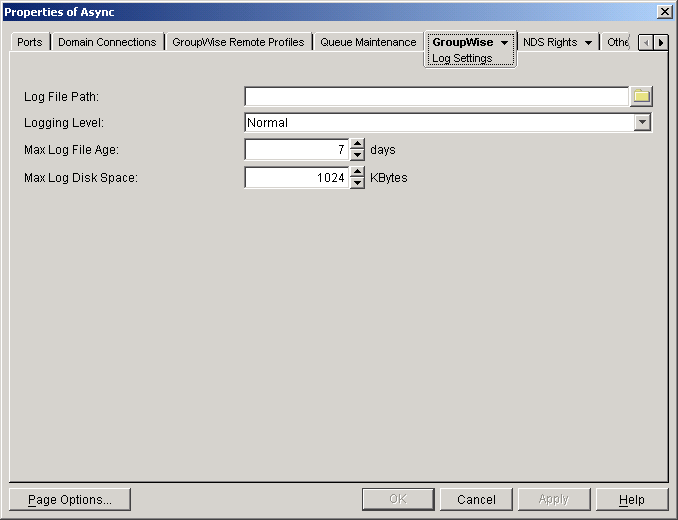Using Async Gateway Log Files
The Async Gateway log files contain operational data useful for tracking gateway activity and for troubleshooting.
The gateway creates a new log file each day and each time the gateway is restarted. The log file is named mmddlog.nnn, where mmdd is the month and day and nnn is the log file number beginning with 001. For example, the first log file created on December 1 would be named 1201log.001. If the gateway were restarted during the day, the second log file would be named 1201log.002.
If you want to use the gateway's logging feature, a variety of logging options are available:
Configuring Log Settings and Switches
-
In ConsoleOne, browse to and select the GroupWise Domain object where you created the gateway.
-
Right-click the Async Gateway object, then click Properties.
-
Click GroupWise > Log Settings.

-
Adjust the following fields as needed:
Log File Path: Specify the directory where you want the Async Gateway to store its log files. By default, the gateway's log files are kept in the domain\wpgate\async\ xxx.prc directory.
You can also set the log file location by including the /log switch on the command line when you start the gateway or in the startup file (gwasync.cfg).
Logging Level: Select how much information is displayed to the gateway operation screen and written to the log file. You can enable gateway logging by selecting any level except None. The other logging levels are:
Normal: Logs standard activity for message routing and processing. This provides a basic summary of all activity.
Verbose: Logs detailed activity for message routing and processing.
Diagnostic: Logs maximum activity for message routing and processing. This level should be used only when troubleshooting a problem with the gateway. This logging level cannot be set at the Gateway Log Settings page. It must be set either with a startup switch or at the gateway operation screen.
You can also set the gateway logging level by including the /loglevel switch on the command line when you start the gateway or in the startup file (gwasync.cfg).
Max Log File Age: Specify the number of days you want the gateway to retain a log file before deleting it. For example, the default (7 days) causes the 1201log.001 to be deleted on 12/9 (December 9).
You can also set the log file age by including the /logdays switch in the command line when you start the gateway or in the startup file (gwasync.cfg). If you use this switch, the range is from 1 to 360 days. Use 0 to designate unlimited number of days.
Max Log Disk Space: Specify the maximum amount of disk space used for all log files. When the limit is reached, the gateway begins to overwrite the existing log files, starting with the oldest one.
You can also set the log file size by including the /logmax switch on the command line when you start the gateway or in the startup file (gwasync.cfg). If you use this switch, the range begins at 256 KB and extends upward indefinitely. Use 0 (zero) to designate an unlimited size.
-
Click OK to save your change.
Viewing the Log File
The Async Gateway log files contain operational data useful for tracking gateway activity and for troubleshooting.
You might want to use log files on a regular basis. You can view the current log file for the gateway session in progress, or an archived log file. Current log files are viewable only in the gateway operation screen, while a saved log file can only be viewed in an ASCII text editor.
To view the current log file, the Async Gateway must be running. The log file is displayed in the Logging window of the Async Gateway server console, with only the most current operations visible. The log file is complete, however, and includes the gateway startup and configuration information, as well as ongoing operations logged by time, including the shutdown operation. You can browse the file or perform a search for any text string you want.
To view the current log file from the gateway operation screen, see Menu Functions